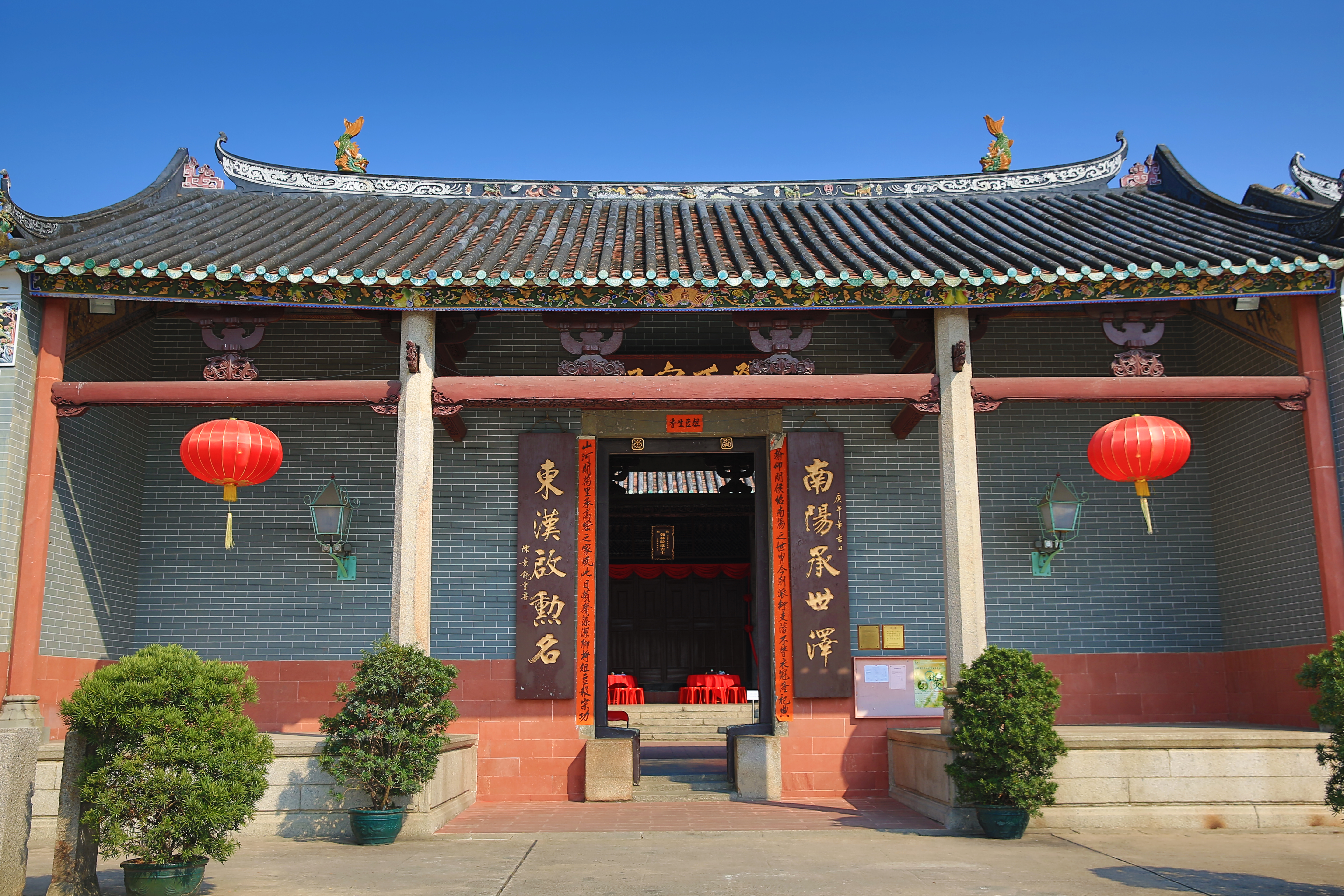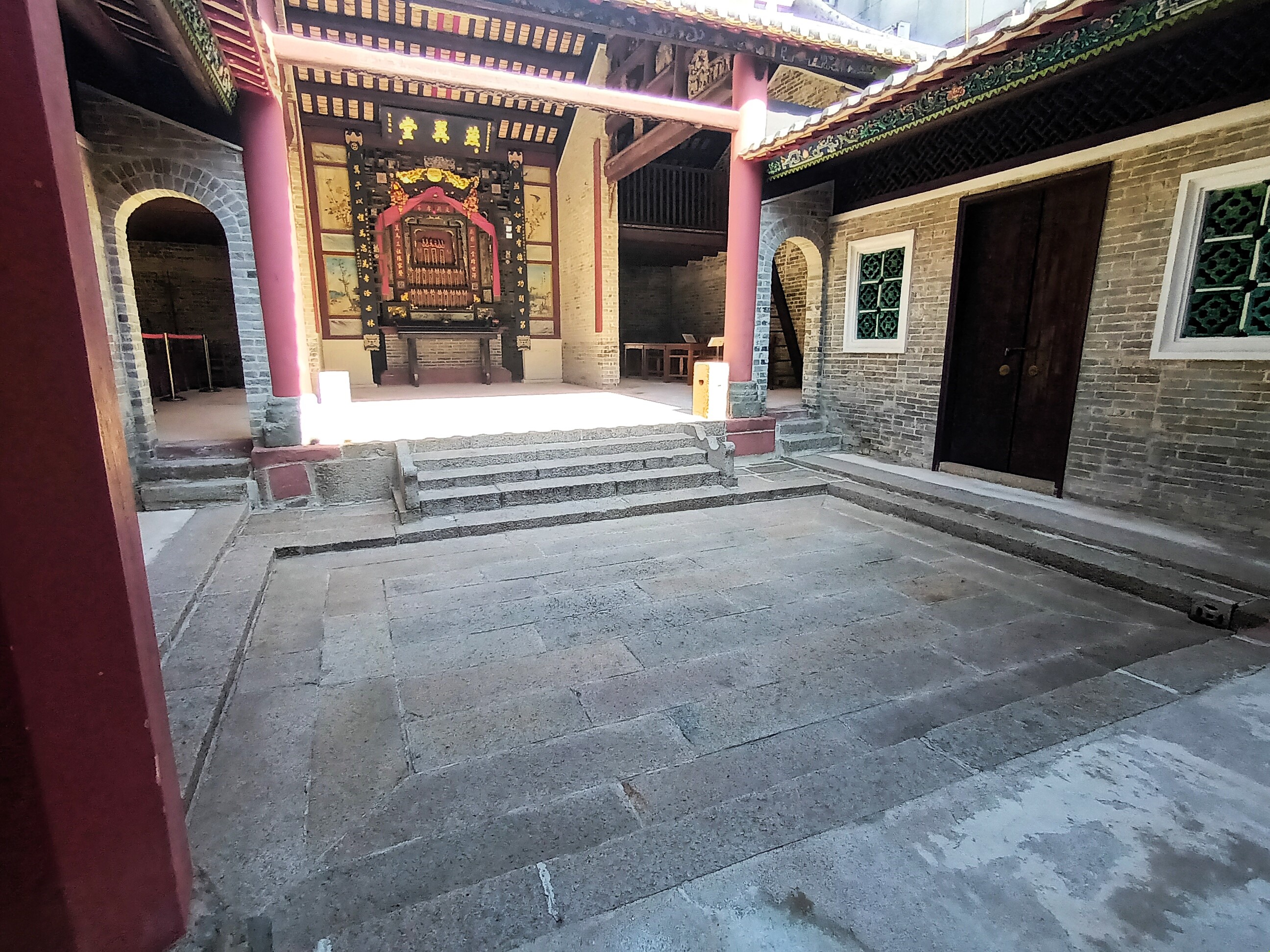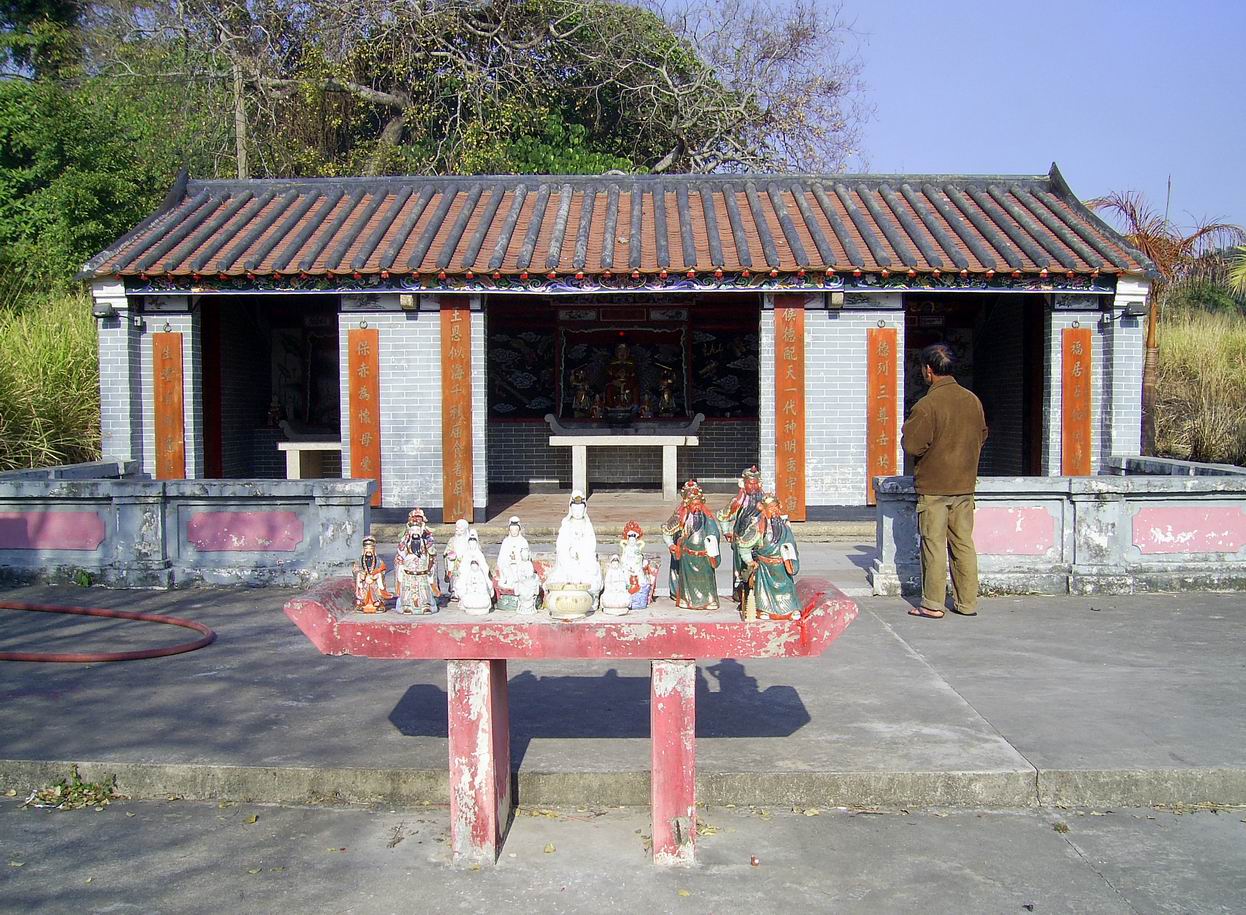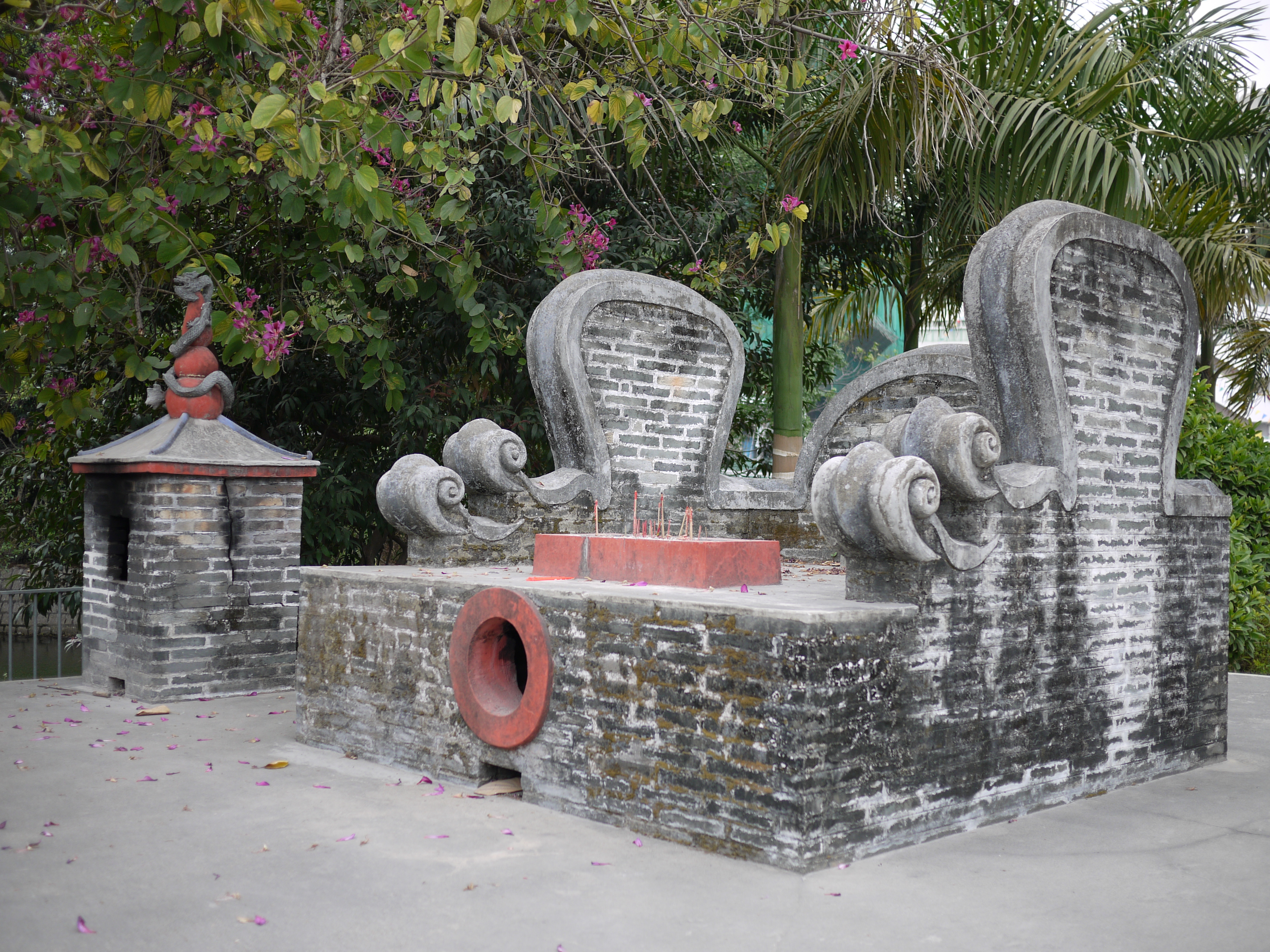Ping Shan Heritage Trail on:
[Wikipedia]
[Google]
[Amazon]










 Ping Shan Heritage Trail is a heritage trail located in the
Ping Shan Heritage Trail is a heritage trail located in the
/ref>
Ping Shan Heritage Trail
/ref> Built about 200 years ago by a line of the Tang Clan that branched out from nearby Hang Tau Tsuen, it is the only walled village along the Ping Shan Heritage Trail. The moat that once surrounded the village has been filled. Three of the original watchtowers have collapsed and only the lower storey of the southwest one remains, which has been converted for residential use.
Website about the sights along Ping Shan Heritage Trail
Ping Shan Heritage Trail
on
Ping Shan Heritage Trail
on
Ping Shan Heritage Trail photos and info
- covers a walk along the trail, with photos en route. * {{coord, 22.4449, 114.0073, display=title Ping Shan Heritage conservation in Hong Kong Museums in Hong Kong Classical Lingnan-style buildings Heritage trails






 Ping Shan Heritage Trail is a heritage trail located in the
Ping Shan Heritage Trail is a heritage trail located in the Ping Shan
Ping Shan () is an area in the New Territories, Hong Kong. It is located west of Yuen Long Town and Shui Pin Wai, and south of Tin Shui Wai. Administratively, it is part of the Yuen Long District.
Geography
Although sandwiched between Yuen L ...
area of Yuen Long District
Yuen Long District (formerly romanised as Un Long) is one of the districts of Hong Kong. Located in the northwest of the New Territories, it had a population of 662,000 in 2021
Geography
Yuen Long District contains the largest alluvial pla ...
, in Hong Kong
Hong Kong ( (US) or (UK); , ), officially the Hong Kong Special Administrative Region of the People's Republic of China ( abbr. Hong Kong SAR or HKSAR), is a city and special administrative region of China on the eastern Pearl River Delt ...
. The trail was inaugurated on 12 December 1993 and was the first of its kind in Hong Kong. It passes through the villages of Hang Tau Tsuen, Hang Mei Tsuen
Hang Mei Tsuen () is a village in the Ping Shan area of Yuen Long District, in Hong Kong. It is part of the Ping Shan Heritage Trail.
Administration
Hang Mei Tsuen is a recognized village under the New Territories Small House Policy.
History
H ...
and Sheung Cheung Wai
Sheung Cheung Wai () is a walled village in the Ping Shan area of Yuen Long District, in Hong Kong. It is part of the Ping Shan Heritage Trail.
Administration
Sheung Cheung Wai is a recognized village under the New Territories Small House Polic ...
and it includes several declared monuments and graded buildings.
The Ping Shan Tang Clan Gallery and Heritage Trail Visitors Centre was opened in 2007. It is housed in the Old Ping Shan Police Station Several police buildings in Hong Kong are listed as historic monuments. While some of them are still serving their initial purpose, most of them have been decommissioned and have been redeveloped or are awaiting redevelopment.
Historic police stati ...
.Ping Shan Tang Clan Gallery cum Heritage Trail Visitors Centre on Antiquities and Monuments website/ref>
Sights included in the trail
The trail includes the following 14 historic buildings:1. Ping Shan Tang Clan Gallery
The Ping Shan Tang Clan Gallery cum Heritage Trail Visitors Centre was opened in 2007. It is housed in theOld Ping Shan Police Station Several police buildings in Hong Kong are listed as historic monuments. While some of them are still serving their initial purpose, most of them have been decommissioned and have been redeveloped or are awaiting redevelopment.
Historic police stati ...
.
2. Hung Shing Temple
ThisHung Shing Temple
Hung Shing Temples or Tai Wong Temples are temples dedicated to Hung Shing Tai Wong (). Hung Shing temples have been widely built in southern China, especially Guangdong province The table provides a partial list of these temples. Hung Shing Fe ...
was constructed by the Tang Clan
The Tang Clan of Hong Kong () is one of the Five Great Clans of the New Territories (). The others are Man (Wen
Wen, wen, or WEN may refer to:
* WEN, New York Stock Exchange symbol for Wendy's/Arby's Group
* WEN, Amtrak station code for Columbi ...
residing in Ping Shan. It was probably built in 1767 during the Qianlong
The Qianlong Emperor (25 September 17117 February 1799), also known by his Temple name, temple name Emperor Gaozong of Qing, born Hongli, was the fifth List of emperors of the Qing dynasty, Emperor of the Qing dynasty and the fourth Qing empe ...
reign of the Qing dynasty
The Qing dynasty ( ), officially the Great Qing,, was a Manchu-led imperial dynasty of China and the last orthodox dynasty in Chinese history. It emerged from the Later Jin dynasty founded by the Jianzhou Jurchens, a Tungusic-speak ...
. The existing structure was rebuilt in 1866, followed by a substantial renovation in 1963. It is a Grade II historic building.
3. Entrance Hall of Shut Hing Study Hall
Shut Hing Study Hall was built in 1874 by the Tang clan to commemorate the ancestor, Tang Shut-hing. The rear hall of the Study Hall was demolished in 1977. It is located inTong Fong Tsuen
Tong Fong Tsuen () is a village in Ping Shan, Yuen Long District, Hong Kong.
Administration
Tong Fong Tsuen is a recognized village under the New Territories Small House Policy.
History
Tong Fong Tsuen is one of the three ''wais'' ( walled vill ...
. It is a Grade I historic building.
4. Kun Ting Study Hall
Kun Ting Study Hall was built by the Tang's for students preparing for the imperial civil service examination. It is a Grade I historic building.5. Ching Shu Hin
Ching Shu Hin is an L-shaped two-storey building, adjoining Kun Ting Study Hall. It was constructed shortly after the completion of the Study Hall in 1870, and was used as a guest house. It is a Grade I historic building.6. Tang Ancestral Hall
The is one of the largestancestral hall
An ancestral shrine, hall or temple ( or , vi, Nhà thờ họ; Chữ Hán: 家祠户), also called lineage temple, is a temple dedicated to deified ancestors and progenitors of surname lineages or families in the Chinese tradition. Ancestra ...
s in the territory. It is located between Hang Mei Tsuen and Hang Tau Tsuen.
It was constructed by Tang Fung-shun, the fifth generation ancestor of Tang Clan
The Tang Clan of Hong Kong () is one of the Five Great Clans of the New Territories (). The others are Man (Wen
Wen, wen, or WEN may refer to:
* WEN, New York Stock Exchange symbol for Wendy's/Arby's Group
* WEN, Amtrak station code for Columbi ...
about 700 years ago. It is the main ancestral hall of the Tang clan of Ping Shan. It is a three-hall structure with two internal courtyards. The wooden brackets and beams of the three halls are carved with auspicious Chinese motifs. Shiwan dragon-fish and pottery unicorns decorate the main ridges and roofs. There are ancestral tablets at the altar at the rear hall.
This ancestral hall is still used regularly for worship and celebrations of traditional festivals and ceremonies, as well as a meeting place for the Tang clan of Ping Shan.
7. Yu Kiu Ancestral Hall
Yu Kiu Ancestral Hall is situated adjacent to Tang Ancestral Hall, both declared monuments on December 14, 2001. There are three halls and two internal courtyards in the compound. The layout and design of Yu Kiu Ancestral Hall is the same as Tang Ancestral Hall. It was built in the early sixteenth century by two eleventh generation brothers of the Tang clan of Ping Shan: Tang Sai-yin (alias Yu-sing) and Tang Sai-chiu (alias Kiu-lum). Apart from serving as an ancestral hall, the building was also used as a teaching hall for youngsters of Ping Shan. It was occupied by a primary school from 1931 to 1961. During the Guangxu reign (1875–1908) of theQing dynasty
The Qing dynasty ( ), officially the Great Qing,, was a Manchu-led imperial dynasty of China and the last orthodox dynasty in Chinese history. It emerged from the Later Jin dynasty founded by the Jianzhou Jurchens, a Tungusic-speak ...
, The last major renovation of the building probably took place; it was indicated by the engraved characters on the stone tablet above the main entrance.
8. Yan Tun Kong Study Hall
() is located in Hang Tau Tsuen. It is adeclared monument
Declared monuments of Hong Kong are places, structures or buildings legally declared to receive the highest level of protection. In Hong Kong, declaring a monument requires consulting the Antiquities Advisory Board, the approval of the Chief Exec ...
.
9. Yeung Hau Temple
It is one of the six temples inYuen Long
Yuen Long is a town in the western New Territories, Hong Kong. To its west lie Hung Shui Kiu (), Tin Shui Wai, Lau Fau Shan and Ha Tsuen, to the south Shap Pat Heung and Tai Tong, to the east Au Tau and Kam Tin (), and to the north Nam Sang W ...
dedicated to Hau Wong
Hau Wong or Hou Wang () is a title that can be translated as ''"Prince Marquis"'' or ''"Holy Marquis"''. It is not any one person's name. Hau Wong refers usually to (), a loyal and courageous general. Despite his failing health, he remained in th ...
. It is a Grade III historic building.
10. Old well
On the trail between Yeung Hau Temple and Sheung Cheung Wai lies an old well that, according to the Tang villagers, was built by the residents of Hang Tau Tsuen more than 200 years ago and before the establishment of Sheung Cheung Wai, although the exact date of its construction cannot be traced. The well was once the main source of drinking water for both villages.11. Sheung Cheung Wai
Sheung Cheung Wai
Sheung Cheung Wai () is a walled village in the Ping Shan area of Yuen Long District, in Hong Kong. It is part of the Ping Shan Heritage Trail.
Administration
Sheung Cheung Wai is a recognized village under the New Territories Small House Polic ...
() is a walled village
A walled village () is a type of large traditional multi-family communal living structure found in China, that is designed to be easily defensible. It is completely surrounded by thick defensive walls, protecting the residents from the attack o ...
. It is one of the "Three Wais" (walled villages) of this part of Ping Shan
Ping Shan () is an area in the New Territories, Hong Kong. It is located west of Yuen Long Town and Shui Pin Wai, and south of Tin Shui Wai. Administratively, it is part of the Yuen Long District.
Geography
Although sandwiched between Yuen L ...
. The other two are Fui Sha Wai () and Kiu Tau Wai
Kiu Tau Wai () is a Walled villages of Hong Kong, walled village in Ping Shan, Yuen Long District, Hong Kong.
Administration
Kiu Tau Wai is a recognized village under the New Territories Small House Policy. It is one of the 37 villages represent ...
().Antiquities and Monuments Office
The Antiquities and Monuments Office (AMO) was established in 1976 under the Antiquities and Monuments Ordinance to protect and preserve Hong Kong's historic monuments. Housed in the Former Kowloon British School, the AMO is responsible for iden ...
Ping Shan Heritage Trail
/ref> Built about 200 years ago by a line of the Tang Clan that branched out from nearby Hang Tau Tsuen, it is the only walled village along the Ping Shan Heritage Trail. The moat that once surrounded the village has been filled. Three of the original watchtowers have collapsed and only the lower storey of the southwest one remains, which has been converted for residential use.
12. Shrine of the Earth God
Not far away to the west of Sheung Cheung Wai lies a shrine dedicated to theEarth God
An Earth god is a deification of the Earth associated with a figure with chthonic or terrestrial attributes.
In Greek mythology, the Earth is personified as Gaia, corresponding to Roman Terra. Egyptian mythology have the sky goddesses, Nut a ...
who is known to the villagers as "She Kung". "She Kung" altars are commonly found in traditional Chinese villages as "She Kung" is believed to be the protector of villagers. "She Kung" is also known as "Pak Kung", "To Tei Kung" and "Fuk Tak Kung". The shrines for "She Kung" are usually simple brick structures on which pieces of stone are placed to symbolize the presence of the Deity.
13. Tsui Sing Lau Pagoda
Tsui Sing Lau Pagoda
The Tsui Sing Lau Pagoda () is the only surviving ancient pagoda in Hong Kong near MTR Tin Shui Wai station and Light Rail Tin Shui Wai stop. It is part of the Ping Shan Heritage Trail and a declared monument.
History
According to Tang Clan ...
() is Hong Kong's only ancient pagoda
A pagoda is an Asian tiered tower with multiple eaves common to Nepal, India, China, Japan, Korea, Myanmar, Vietnam, and other parts of Asia. Most pagodas were built to have a religious function, most often Buddhist but sometimes Taoist, ...
.
The name in Chinese means "Pagoda of Gathering Stars". It became a declared monument
Declared monuments of Hong Kong are places, structures or buildings legally declared to receive the highest level of protection. In Hong Kong, declaring a monument requires consulting the Antiquities Advisory Board, the approval of the Chief Exec ...
on 14 December 2001.
The Pagoda was built by Tang Yin-tung, the seventh generation ancestor, more than 600 years ago according to the genealogy of the Tang clan of Ping Shan. Oral history indicates the pagoda was originally a seven-storey hexagonal-shaped green-brick structure, but was damaged due to strong weather. At present it is a three-storey structure and it is about thirteen metres high. On the top floor, a statue of Fui Shing (Champion Star) is worshipped.
The pagoda was built to improve the '' feng shui'' of the locality so that flooding disasters were prevented to the village. It was also believed that its auspicious location, which is in alignment with Castle Peak, would ensure success for clan members in the Imperial Civil Service Examination. In fact, the Tang clan of Ping Shan has produced numerous scholars and officials.
14. Tat Tak Communal Hall
Tat Tak Communal Hall () is located north-west of Sheung Cheung Wai. It is aDeclared monument
Declared monuments of Hong Kong are places, structures or buildings legally declared to receive the highest level of protection. In Hong Kong, declaring a monument requires consulting the Antiquities Advisory Board, the approval of the Chief Exec ...
.
Other sights
Several other historic buildings located in the area covered by the trail are not officially part of the trail. They include:Fui Sha Wai
Fui Sha Wai () is awalled village
A walled village () is a type of large traditional multi-family communal living structure found in China, that is designed to be easily defensible. It is completely surrounded by thick defensive walls, protecting the residents from the attack o ...
. It is one of the "Three Wais" of this part of Ping Shan.
Kiu Tau Wai
Kiu Tau Wai
Kiu Tau Wai () is a Walled villages of Hong Kong, walled village in Ping Shan, Yuen Long District, Hong Kong.
Administration
Kiu Tau Wai is a recognized village under the New Territories Small House Policy. It is one of the 37 villages represent ...
() is a walled village
A walled village () is a type of large traditional multi-family communal living structure found in China, that is designed to be easily defensible. It is completely surrounded by thick defensive walls, protecting the residents from the attack o ...
. It is one of the "Three Wais" of this part of Ping Shan.
Ng Kwai Tong
() is a sub-family ancestral Hall in Hang Tau Tsuen. It was probably built in 1822.Sau Choi Mansion
(), located at No. 64 Hang Mei Tsuen, is a 160-year-old mansion, handed down through six generations. As its former residents, Tang Shut-hing and Tang Tai-shing obtained the official posts through imperial civil service examination, the house is now called Sau Choi Mansion. The house was refurnished and now houses relics and information Tang clan. Tours are able to be arranged on Saturdays, Sundays and Public Holidays.Sing Hin Kung Study Hall
() is located in Hang Mei Tsuen. It is a Grade II historic building. Not open to the public.Yeuk Hui Study Hall
(), located in Hang Mei Tsuen, is listed as a Grade III historic building.See also
* Heritage trails in Hong Kong *Lung Yeuk Tau Heritage Trail
Lung Yeuk Tau (), commonly known as Lung Ku Tau () and also called Lung Ling () is an area located northeast of Luen Wo Hui in Fanling, New Territories, Hong Kong.
Administration
For electoral purposes, Lung Yeuk Tau is part of the Queen's Hil ...
, in Fanling
References
External links
Ping Shan Heritage Trail
on
Antiquities and Monuments Office
The Antiquities and Monuments Office (AMO) was established in 1976 under the Antiquities and Monuments Ordinance to protect and preserve Hong Kong's historic monuments. Housed in the Former Kowloon British School, the AMO is responsible for iden ...
website
Ping Shan Heritage Trail
on
Education and Manpower Bureau
The Education Bureau (EDB) is responsible for formulating and implementing education policies in Hong Kong.
The bureau is headed by the Secretary for Education and oversees agencies including University Grants Committee and Student Fina ...
website
Ping Shan Heritage Trail photos and info
- covers a walk along the trail, with photos en route. * {{coord, 22.4449, 114.0073, display=title Ping Shan Heritage conservation in Hong Kong Museums in Hong Kong Classical Lingnan-style buildings Heritage trails